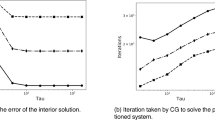Abstract
We consider a (possibly) nonlinear interface problem in 2D and 3D, which is solved by use of various adaptive FEM-BEM coupling strategies, namely the Johnson–Nédélec coupling, the Bielak–MacCamy coupling, and Costabel’s symmetric coupling. We provide a framework to prove that the continuous as well as the discrete Galerkin solutions of these coupling methods additionally solve an appropriate operator equation with a Lipschitz continuous and strongly monotone operator. Therefore, the original coupling formulations are well-defined, and the Galerkin solutions are quasi-optimal in the sense of a Céa-type lemma. For the respective Galerkin discretizations with lowest-order polynomials, we provide reliable residual-based error estimators. Together with an estimator reduction property, we prove convergence of the adaptive FEM-BEM coupling methods. A key point for the proof of the estimator reduction are novel inverse-type estimates for the involved boundary integral operators which are advertized. Numerical experiments conclude the work and compare performance and effectivity of the three adaptive coupling procedures in the presence of generic singularities.
Similar content being viewed by others
References
Ainsworth M, Oden JT (2000) A posteriori error estimation in finite element analysis. Wiley-Interscience, Wiley, New-York
Aurada M, Ebner M, Feischl M, Ferraz-Leite S, Goldenits P, Karkulik M, Mayr M, Praetorius D (2011) HILBERT: a Matlab implementation of adaptive 2D-BEM. ASC Report 24/2011, Institute for Analysis and Scientific Computing, Vienna University of Technology, Wien, software download at http://www.asc.tuwien.ac.at/abem/hilbert/
Aurada M, Ferraz-Leite S, Praetorius D (2012) Estimator reduction and convergence of adaptive BEM. Appl Numer Math 62: 787–801
Aurada M, Feischl M, Führer T, Karkulik M, Melenk JM, Praetorius D (2012) Inverse estimates for elliptic integral operators and application to the adaptive coupling of FEM and BEM (preprint)
Aurada M, Feischl M, Karkulik M, Praetorius D (2012) A posteriori error estimates for the Johnson–Nédélec FEM-BEM coupling. Eng Anal Bound Elem 36: 255–266
Aurada M, Feischl M, Praetorius D (2012) Convergence of some adaptive FEM-BEM coupling for elliptic but possibly nonlinear interface problems. Math Model Numer Anal 46: 1147–1173
Aurada M, Karkulik M, Praetorius D (2012) Simple error estimates for hypersingular integral equations in adaptive 3D-BEM (in progress)
Bielak J, MacCamy RC (1983/1984) An exterior interface problem in two-dimensional elastodynamics. Quart Appl Math 41:143–159
Carstensen C (1996) A posteriori error estimate for the symmetric coupling of finite elements and boundary elements. Computing 57: 301–322
Carstensen C, Funken SA, Stephan EP (1997) On the adaptive coupling of FEM and BEM in 2-d-elasticity. Numer Math 77: 187–221
Carstensen C, Maischak M, Stephan EP (2001) A posteriori error estimate and h-adaptive algorithm on surfaces for Symm’s integral equation. Numer Math 90: 197–213
Carstensen C, Stephan E (1995) Adaptive coupling of boundary elements and finite elements. Math Model Numer Anal 29: 779–817
Cascon M, Kreuzer C, Nochetto R, Siebert K (2008) Quasi-optimal convergence rate for an adaptive finite element method. SIAM J Numer Anal 46: 2524–2550
Costabel MA (1988) symmetric method for the coupling of finite elements and boundary elements. In: Whiteman J (ed) The mathematics of finite elements and applications IV, MAFELAP 1987, Academic Press, London, pp 281–288
Costabel M, Ervin VJ, Stephan EP (1991) Experimental convergence rates for various couplings of boundary and finite elements. Math Comput Model 15: 93–102
Costabel M, Stephan EP (1990) Coupling of finite and boundary element methods for an elastoplastic interface problem. SIAM J Numer Anal 27: 1212–1226
Feischl M, Karkulik M, Melenk JM, Praetorius D (2011) Quasi-optimal convergence rate for an adaptive boundary element method. ASC Report 28/2011, Institute for Analysis and Scientific Computing, Vienna University of Technology, Wien
Gatica G, Hsiao G (1995) Boundary-field equation methods for a class of nonlinear problems. Longman, Harlow
Gatica G, Hsiao G, Sayas FJ (2012) Relaxing the hypotheses of Bielak–MacCamy’s BEM-FEM coupling. Numer Math 120: 465–487
Graham I, Hackbusch W, Sauter S (2005) Finite elements on degenerate meshes: inverse-type inequalities and applications. IMA J Numer Anal 25: 379–407
Hsiao G, Wendland W (2008) Boundary integral equations. Applied mathematical sciences 164. Springer, Berlin
Johnson C, Nédélec JC (1980) On the coupling of boundary integral and finite element methods. Math Comp 35: 1063–1079
Leydecker F, Maischak M, Stephan EP, Teltscher M (2010) Adaptive FE-BE coupling for an electromagnetic problem in \({\mathbb {R}^3}\) : a residual error estimator. Math Methods Appl Sci 33: 2162–2186
McLean W (2000) Strongly elliptic systems and boundary integral equations. Cambridge University Press, Cambridge
Sauter S, Schwab C (2011) Boundary element methods. Springer, Berlin
Sayas FJ (2009) The validity of Johnson–Nédélec’s BEM-FEM coupling on polygonal interfaces. SIAM J Numer Anal 47: 3451–3463
Scott LR, Zhang S (1990) Finite element interpolation of nonsmooth functions satisfying boundary conditions. Math Comp 54: 483–493
Steinbach O (2008) Numerical approximation methods for elliptic boundary value problems: Finite and boundary elements. Springer, New York
Steinbach O (2011) A note on the stable one-equation coupling of finite and boundary elements. SIAM J Numer Anal 49: 1521–1531
Stephan EP, Maischak M (2005) A posteriori error estimates for fem-bem couplings of three-dimensional electromagnetic problems. Methods Appl Mech Eng 1994: 441–452
Stevenson R (2008) The completion of locally refined simplicial partitions created by bisection. Math Comp 77: 227–241
Zeidler E (1990) Nonlinear functional analysis and its applications, part II/B. Springer, New York
Zienkiewicz OC, Kelly DW, Bettess P (1979) Marriage la mode: the best of both worlds (finite elements and boundary integrals). Energy methods in finite element analysis. Wiley, Chichester
Author information
Authors and Affiliations
Corresponding author
Rights and permissions
About this article
Cite this article
Aurada, M., Feischl, M., Führer, T. et al. Classical FEM-BEM coupling methods: nonlinearities, well-posedness, and adaptivity. Comput Mech 51, 399–419 (2013). https://doi.org/10.1007/s00466-012-0779-6
Received:
Accepted:
Published:
Issue Date:
DOI: https://doi.org/10.1007/s00466-012-0779-6




